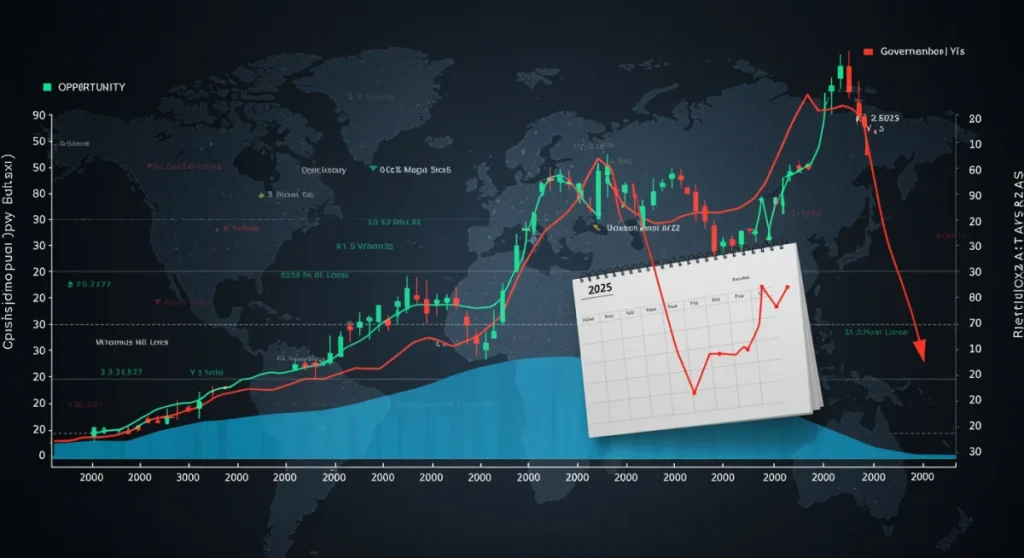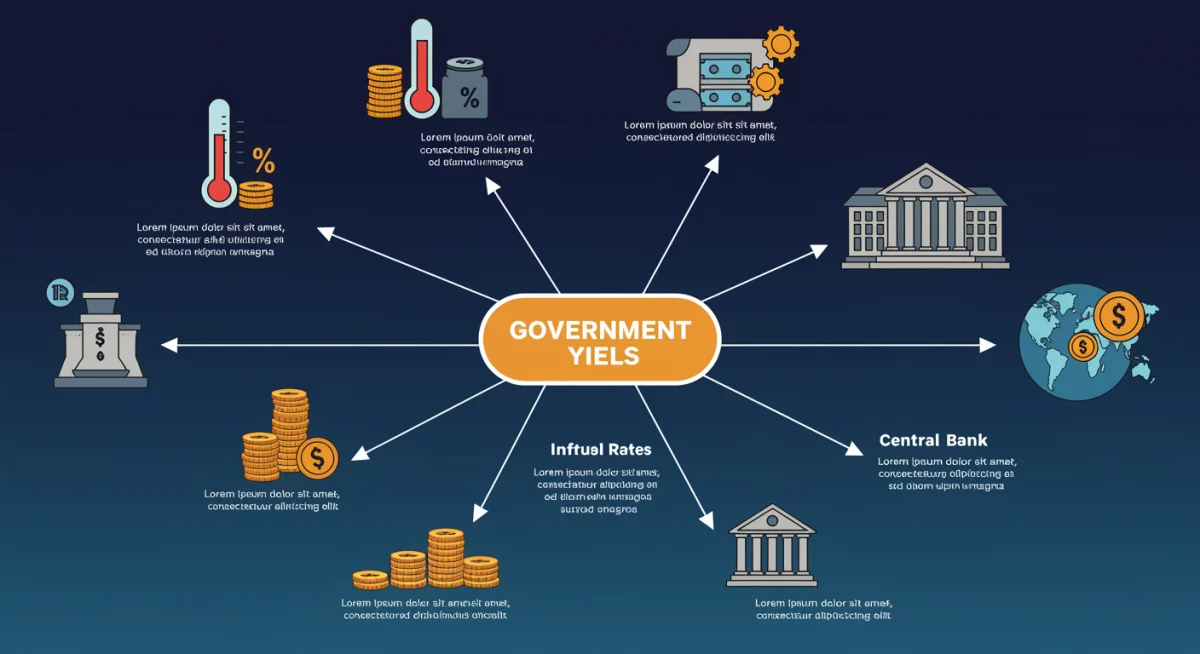2025 Government Bond Market: Opportunities & Risks for Investors

Anúncios
Understanding the 2025 Government Bond Market involves a nuanced analysis of economic forecasts, monetary policy shifts, and geopolitical factors to identify both lucrative opportunities and significant risks for investors seeking stable returns.
Anúncios
As we approach 2025, the landscape for fixed-income investors, particularly within the realm of government bonds, is poised for significant shifts. Understanding the 2025 Government Bond Market is crucial for anyone looking to secure their financial future or optimize their portfolio. This period promises a complex interplay of economic forces, central bank policies, and global events that will undoubtedly shape the value and appeal of government debt. Investors must be prepared to analyze these dynamics to make informed decisions.
Anúncios
The Current Economic Climate and Its Impact on Bonds
The economic environment leading into 2025 is characterized by a unique blend of persistent inflation, evolving monetary policies, and varying global growth trajectories. These factors collectively exert considerable influence on government bond yields and prices. Understanding this context is the first step in formulating an effective investment strategy.
Central banks, particularly the Federal Reserve, have been navigating a challenging period, balancing inflation control with economic stability. Their decisions on interest rates are paramount, directly affecting the attractiveness of newly issued government bonds.
Inflationary Pressures and Monetary Policy
Inflation has been a dominant theme across major economies, leading central banks to adopt tighter monetary policies. This has direct implications for bond markets.
- Interest Rate Hikes: Higher policy rates generally translate to higher bond yields as investors demand greater compensation for holding debt in an inflationary environment.
- Quantitative Tightening: Central banks reducing their balance sheets by selling off bonds can increase the supply in the market, potentially pushing yields higher.
- Forward Guidance: Statements from central bank officials about future policy intentions can significantly influence market expectations and bond pricing.
The interplay between inflation and interest rates creates a dynamic environment where bond prices and yields move inversely. When interest rates rise, existing bonds with lower yields become less attractive, causing their prices to fall. Conversely, when rates fall, older bonds with higher yields become more valuable.
Geopolitical Landscape and Its Influence
Beyond economic fundamentals, geopolitical developments play an increasingly significant role in the stability and attractiveness of government bonds. Global conflicts, trade disputes, and political instability can trigger flight-to-safety events, where investors flock to perceived safe-haven assets like U.S. Treasury bonds, regardless of prevailing yields.
The interconnectedness of the global economy means that events in one region can have ripple effects across financial markets. This necessitates a broader perspective when assessing the risks and opportunities within the 2025 government bond market.
Key Geopolitical Factors to Monitor
Several geopolitical elements warrant close attention from bond investors:
- International Relations: Tensions between major global powers can lead to increased volatility and a demand for safe assets.
- Regional Conflicts: Localized conflicts can disrupt supply chains and commodity markets, fueling inflation or slowing economic growth, thereby impacting bond yields.
- Trade Policies: Shifts in trade agreements or the imposition of tariffs can affect economic growth prospects and inflation, influencing central bank decisions.
These factors introduce an element of unpredictability, making diligent monitoring crucial for bond investors. The perceived safety of government bonds can fluctuate rapidly in response to these global events, often creating both unexpected risks and temporary opportunities for those who can react swiftly.
Technological Advancements and Market Efficiency
The financial markets are continually evolving, driven by rapid technological advancements. For the 2025 Government Bond Market, this means enhanced data analytics, algorithmic trading, and the increasing role of artificial intelligence in market predictions. These technologies can lead to greater market efficiency but also introduce new forms of volatility and risk.
Investors now have access to more sophisticated tools for analyzing market data, enabling quicker identification of trends and potential arbitrage opportunities. However, the speed of information dissemination and algorithmic responses can also amplify market movements, making rapid reactions essential.

The rise of decentralized finance (DeFi) and blockchain technology, while not directly impacting traditional government bonds in the same way, could indirectly influence market dynamics by offering alternative investment avenues or transforming settlement processes. This evolving technological landscape demands that investors stay updated not just on economic news, but also on the innovations shaping financial infrastructure.
Data Analytics and Predictive Modeling
Advanced data analytics and predictive modeling are becoming indispensable for bond investors. These tools can process vast amounts of economic data, news sentiment, and geopolitical indicators to forecast market movements.
- Algorithmic Trading: Automated systems execute trades based on predefined criteria, often reacting to market changes faster than human traders.
- AI-Driven Insights: Artificial intelligence can identify complex patterns and correlations that might escape human observation, offering deeper insights into market behavior.
- Enhanced Risk Management: Technology aids in more sophisticated risk assessment, allowing investors to quantify and manage their exposure more effectively.
While these tools offer significant advantages, they also require a deep understanding of their limitations and potential biases. Over-reliance on models without human oversight can lead to unforeseen risks, especially in black swan events. The future of bond investing will likely involve a synergistic approach, combining technological prowess with seasoned human judgment.
Opportunities for Investors in 2025
Despite the complexities, the 2025 Government Bond Market will present several opportunities for astute investors. Higher interest rates, if they materialize, could offer more attractive yields compared to recent years, making government bonds a compelling option for income generation.
Furthermore, periods of economic uncertainty often lead to a flight to quality, where government bonds, particularly those from highly rated nations like the U.S., become desirable safe havens. This demand can temporarily boost prices and offer capital appreciation opportunities for those who anticipate such shifts.
Diversification and Portfolio Stability
Government bonds traditionally serve as a cornerstone for portfolio diversification, offering stability during equity market downturns. In 2025, this role is expected to remain critical.
- Reduced Volatility: Bonds can help cushion a portfolio against the inherent volatility of stock markets.
- Income Generation: Stable coupon payments provide a reliable income stream, particularly valuable in retirement planning.
- Inflation Protection (TIPS): Treasury Inflation-Protected Securities (TIPS) offer a direct hedge against inflation, adjusting their principal value with changes in the Consumer Price Index.
Investors should consider staggering bond maturities (laddering) to mitigate interest rate risk and ensure a consistent reinvestment strategy. This allows portions of their portfolio to mature regularly, enabling them to reinvest at prevailing rates, whether higher or lower. This methodical approach can smooth out returns over time, reducing the impact of short-term market fluctuations.
Risks and Challenges in the Bond Market
While opportunities abound, the 2025 Government Bond Market is not without its risks. The primary concern for fixed-income investors remains interest rate risk. If interest rates continue to rise, the value of existing bonds with lower yields will decline. This can lead to capital losses for investors who need to sell their bonds before maturity.
Inflation risk is another significant challenge. If inflation outpaces bond yields, the real return on investment diminishes, eroding purchasing power. This is particularly problematic for traditional fixed-rate bonds that do not offer inflation protection.
Credit Risk and Sovereign Debt
While often considered low risk, government bonds are not entirely immune to credit risk, especially those issued by nations with less stable economies or high debt-to-GDP ratios. Sovereign credit ratings provide an indication of this risk.
- Downgrades: A downgrade in a country’s credit rating can lead to a sharp decline in the value of its bonds and an increase in borrowing costs.
- Default Risk: Although rare for major economies, the possibility of a sovereign default, even partial, can have catastrophic consequences for bondholders.
- Currency Risk: For international investors, fluctuations in exchange rates can affect the real return on foreign government bonds.
Liquidity risk, though generally lower for highly traded government bonds, can also be a factor in volatile markets. If there’s a sudden need to sell bonds in a market with few buyers, prices may have to be significantly discounted, resulting in losses. Understanding these risks is fundamental to constructing a resilient bond portfolio.
Strategic Approaches for 2025 Investors
Navigating the 2025 Government Bond Market requires a thoughtful and adaptable investment strategy. Investors should focus on diversification, active management, and staying informed about economic and geopolitical developments. A one-size-fits-all approach is unlikely to yield optimal results.
Consider a mix of short-term and long-term bonds to balance liquidity with yield potential. Short-term bonds offer less interest rate risk, while long-term bonds typically provide higher yields but are more sensitive to interest rate changes. This balanced approach can help mitigate some of the inherent volatility.
Portfolio Diversification and Active Management
Diversifying across different types of government bonds and other fixed-income instruments can significantly reduce risk. Active management allows for adjustments to the portfolio in response to changing market conditions.
- Bond Ladders: Staggering bond maturities across different time frames to manage interest rate risk.
- Barbell Strategy: Investing in both very short-term and very long-term bonds, with minimal mid-term holdings, to capture yield at the long end while maintaining liquidity at the short end.
- Inflation-Indexed Bonds: Including TIPS in a portfolio provides a direct hedge against rising inflation.
Consulting with a financial advisor can provide personalized insights and help tailor a strategy that aligns with individual risk tolerance and financial goals. The dynamic nature of the 2025 government bond market demands a proactive stance, where continuous monitoring and strategic adjustments are key to success.
| Key Aspect | Brief Description |
|---|---|
| Economic Outlook | Inflation, interest rates, and global growth forecasts heavily influence bond yields and prices. |
| Key Opportunities | Potential for attractive yields, safe-haven demand, and portfolio diversification benefits. |
| Primary Risks | Interest rate risk, inflation erosion, and geopolitical instability affecting bond values. |
| Strategic Approach | Diversification, active management, and informed decision-making are crucial for success. |
Frequently Asked Questions About the 2025 Government Bond Market
The primary risk is interest rate risk. If central banks continue to raise rates or keep them elevated, the value of existing bonds with lower fixed interest payments will decrease, potentially leading to capital losses for investors who need to sell before maturity.
High inflation can erode the real return on government bonds. If the inflation rate is higher than the bond’s yield, the purchasing power of the investment’s returns diminishes, even if the nominal return is positive.
Yes, U.S. Treasury bonds are generally still considered a safe haven asset due to the strength of the U.S. economy and the dollar. However, their appeal can fluctuate based on interest rate differentials and global economic stability.
Central bank policies, particularly decisions on benchmark interest rates and quantitative easing/tightening, directly influence bond yields and prices. Their actions aim to manage inflation and economic growth, which are key drivers for bond valuations.
Investors can mitigate risks through diversification across various bond types and maturities, utilizing bond ladders, and considering inflation-indexed securities like TIPS. Active monitoring of economic indicators and geopolitical events is also crucial for timely adjustments.
Conclusion
The 2025 Government Bond Market presents a complex yet fascinating landscape for investors. While the allure of stable income and portfolio diversification remains strong, a confluence of economic, geopolitical, and technological factors demands a nuanced and adaptable investment approach. Success in this environment hinges on a deep understanding of market dynamics, proactive risk management, and a willingness to adjust strategies in response to evolving conditions. By carefully analyzing the opportunities and diligently navigating the inherent risks, investors can strategically position their portfolios for resilience and growth in the coming year.